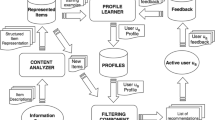Abstract
The main purpose of collaborative filtering algorithm is to provide a personalized recommender system based on past interactions of each user (e.g., clicks and purchases). Among various collaborative filtering techniques, matrix factorization is widely adopted in diverse applications. This technique has superior characteristics, including applying latent feature vectors to represent users or items and projecting users and items into a shared latent feature space. In the present study, a matrix factorization model with the neural embedding called the neural embedding collaborative filtering (NECF) is proposed. In order to evaluate the performance of the proposed method, a probabilistic auto-encoder is initially applied to achieve unsupervised learning to generate the neural embedding vector from the user–item data. Secondly, these vectors are combined with a regression model based on single point negative sampling to represent the latent feature vectors of the user with regression coefficients. Moreover, an inner product is applied on latent features of users and items to determine the correlations between them. It should be indicated that the NECF is generic so that it can express and generalize the matrix factorization under its framework. In the present study, a ridge regression learning is applied on latent features of each user. The experimental results on two benchmark data sets show that the proposed model outperforms other state-of-the-art methods.




Similar content being viewed by others
References
Barkan O, Koenigstein N (2016) Item2vec: neural item embedding for collaborative filtering. In: 2016 IEEE 26th International workshop on machine learning for signal processing (MLSP). IEEE, pp 1–6
Deng Z, Huang L, Wang C, Lai J, Yu PS (2019) DeepCF: a unified framework of representation learning and matching function learning in recommender system. In: National conference on artificial intelligence
Ebesu T, Shen B, Fang Y (2018) Collaborative memory network for recommendation systems. In: International ACM SIGIR conference on research and development in information retrieval
Goldberg Y, Levy O (2014) word2vec explained: deriving Mikolov et al.’s negative-sampling word-embedding method. Eprint Arxiv
He X, Chua TS (2017) Neural factorization machines for sparse predictive analytics. In: Proceedings of the 40th international ACM SIGIR conference on research and development in information retrieval
He X, Liao L, Zhang H et al (2017) Neural collaborative filtering. In: The web conference, 2017, pp 173–182
He X, Chen T, Kan M, Chen X (2015) TriRank: review-aware explainable recommendation by modeling aspects. In: Conference on information and knowledge management
He X, Zhang H, Kan M, Chua T (2016) Fast matrix factorization for online recommendation with implicit feedback. In: International ACM SIGIR conference on research and development in information retrieval
Hoerl A, Kennard R (1970) Ridge regression: applications to nonorthogonal problems. Technometrics 12(1):69–82
Hu Y, Koren Y, Volinsky C (2009) Collaborative filtering for implicit feedback datasets. In: Eighth IEEE international conference on data mining
Kingma DP, Ba J (2014) Adam: a method for stochastic optimization. arXiv: Learning
Koren Y (2008) Factorization meets the neighborhood: a multifaceted collaborative filtering model. In: ACM SIGKDD International conference on knowledge discovery and data mining, pp 426–434
Koren Y, Bell R, Volinsky C (2009) Matrix factorization techniques for recommender systems. Computer 42(8):30–37
Landgraf AJ, Bellay J (2017) word2vec Skip-gram with negative sampling is a weighted logistic PCA. arXiv: Computation and Language
Liang H, Baldwin T (2015) A probabilistic rating auto-encoder for personalized recommender systems. In: ACM International on conference on information and knowledge management
Mikolov T, Chen K, Corrado G, Dean J (2013) Efficient estimation of word representations in vector space. arXiv preprint arXiv:1301.3781
Mikolov T, Sutskever I, Chen K, Corrado G, Dean J (2013) Distributed representations of words and phrases and their compositionality. Adv Neural Inf Process Syst 26:3111–3119
Mu C, Yang G, Yan Z (2018) Revisiting skip-gram negative sampling model with rectification
Ning X, Karypis G (2012) Slim: sparse linear methods for top-\(n\) recommender systems. In: IEEE International conference on data mining
Ozsoy MG (2016) From word embeddings to item recommendation. arXiv: Learning
Pan R, Zhou Y, Cao B, Liu NN, Lukose R, Scholz MB, Yang Q (2008) One-class collaborative filtering. In: International conference on data mining
Rendle S (2010) Factorization machines. In: International conference on data mining
Rendle S, Freudenthaler C, Gantner Z, Schmidt-Thieme L (2009) BPR: Bayesian personalized ranking from implicit feedback. In: Conference on uncertainty in artificial intelligence
Salakhutdinov R, Mnih A (2007) Probabilistic matrix factorization. In: International conference on neural information processing systems
Sarwar BM, Karypis G, Konstan JA (2001) Item-based collaborative filtering recommendation algorithms. In: WWW, pp 285–295
Socher R, Chen D, Manning CD, Ng AY (2013) Reasoning with neural tensor networks for knowledge base completion. In: International conference on neural information processing systems
Xue G, Zhang H, Bian J, Chua TS (2015) Learning image and user features for recommendation in social networks. In: IEEE International conference on computer vision
Xue HJ, Dai X, Zhang J, Huang S, Chen J (2017) Deep matrix factorization models for recommender systems. In: International joint conference on artificial intelligence, pp 3203–3209
Yao W, Dubois C, Zheng AX, Ester M (2016) Collaborative denoising auto-encoders for top-\(n\) recommender systems. In: ACM International conference on web search and data mining
Zhang H, Ji Y, Li J, Ye Y (2016) A triple wing harmonium model for movie recommendation. IEEE Trans Ind Inf 12(1):231–239
Zhang H, Sun Y, Zhao M, Chow TW, Wu QM (2019) Bridging user interest to item content for recommender systems: an optimization model. IEEE Trans Cybern. https://doi.org/10.1109/TCYB.2019.2900159
Author information
Authors and Affiliations
Corresponding author
Ethics declarations
Conflict of interest
The authors declare that they have no conflict of interest.
Additional information
Publisher's Note
Springer Nature remains neutral with regard to jurisdictional claims in published maps and institutional affiliations.
Rights and permissions
About this article
Cite this article
Huang, T., Zhang, D. & Bi, L. Neural embedding collaborative filtering for recommender systems. Neural Comput & Applic 32, 17043–17057 (2020). https://doi.org/10.1007/s00521-020-04920-9
Received:
Accepted:
Published:
Issue Date:
DOI: https://doi.org/10.1007/s00521-020-04920-9




